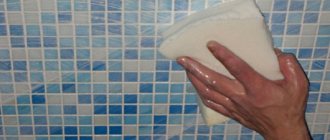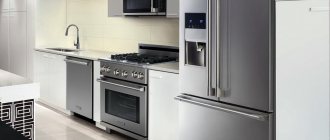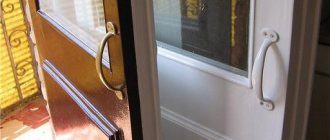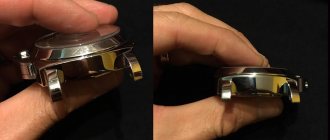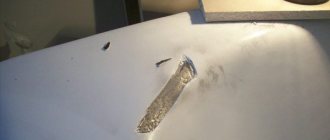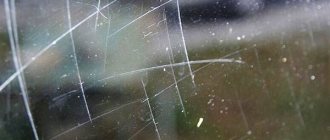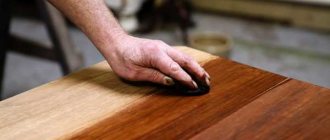Step-by-step guide with description and diagrams: how to seal a hob yourself
If a crack develops on the cooktop, over time it will widen and turn into a crack.
This is dangerous for the user and there is a risk of electric shock. The most reliable way to correct the situation is to replace the damaged surface with a new one. The price for such a service, including spare parts, is about 50% of the cost of a new household appliance. In order to save money, some users decide to repair the hob themselves. For this purpose, a material is used that can hold glass ceramics, preventing cracks from enlarging, and that is resistant to high temperatures.
The most common option is silicate (stationery) glue. It is used along the entire length of the crack, adding pieces of ordinary glass. When chipped, when a fragment is missing, epoxy resin is used. The design is reliable, but looks unaesthetic.
To repair the panel, the following tools and materials are required:
- silicate glue;
- silicone;
- rectangular pieces of glass (approximately 4x9 cm);
- epoxy resin;
- rubber spatula;
- aluminum plate, size depends on the dimensions of the crack.
Step by step guide:
- The stove is unplugged and allowed to cool.
- Remove the panel and wipe with a degreaser.
- The crack is lubricated along its entire length with silicate glue.
- In places where there are no burners, reinforcing elements are glued. Pieces of glass are attached to silicone to give rigidity to the structure.
- Instead of the missing fragment of glass ceramics, epoxy resin is poured in, leveling with a rubber spatula.
- An aluminum plate is glued under the cracked surface.
- :
- How to choose between a hob and a gas stove.
- Products for washing and cleaning glass hobs.
How to remove small scratches?
First, inspect the scratch. If you conclude that it is small and shallow, then use the following means:
Toothpaste
It will help remove only very small and shallow damage.
- Take toothpaste.
- Squeeze a small amount onto a clean polishing cloth.
Important! Take toothpaste only with a whitening effect and preferably if it is transparent.
- Wipe.
- Remove any residue with a clean, damp cloth.
- Repeat the procedure as needed.
Important! For large and deep damage, this method is not suitable.
Ammonia
Ammonia is also able to smooth the surface and remove defects if they are small. To remove scratches on glass using this product, follow these instructions:
- Mix water with ammonia in the following ratio - 3 glasses of water and 15 ml of ammonia.
- Apply the solution to a napkin.
- Rub in circular motions.
- Remove any leftovers.
- Repeat if necessary.
Special cases
Let us finally give two unpleasant examples of pollution that you can also deal with yourself. Sugar, when heated on glass ceramics, instantly caramelizes. As a result, it hardens and firmly adheres to the surface. When you clean such contamination, you may accidentally scratch the stove. That's why you should always have a special scraper on hand to remove the still liquid sugar as quickly as you can.
The same applies to melted plastic that falls on a hot surface. If the plastic is frozen, turn the stove to the lowest temperature, melt it and quickly remove it with a scraper.
Use these easy 8 tips to keep your glass ceramic hob clean.
We suggest you familiarize yourself with How to wash a men's classic and ski suit
Progress does not stand still, and one of its manifestations for housewives is the emergence of a variety of household appliances, which have a lot of useful properties compared to the previous ones. For example, massive stoves have been replaced by hobs that are lightweight, comfortable and very ergonomic.
However, despite its advantages and attractive appearance, the question of cleaning it and bringing it into proper appearance remains open. No matter how careful you are in the process of preparing culinary masterpieces, drops of fat, evaporation, boiled-off broths and other liquid dishes, as well as other stains will remain on the surface of the panel.
Of course, they need to be promptly wiped with a rag after cooling, but there are times when this cannot be done, so we end up with unsightly burnt spots and stains on our kitchen helper.
Despite the traditional Russian tradition, before you start using the panel, carefully read the rules for its operation and care! This will save you from unnecessary hassle, and will allow it to serve you faithfully for many years.
This glossy surface should be cleaned daily after use.
For cooking, you should use only serviceable containers with a flat bottom. During use, pots and pans develop cracks and dents, which during cooking can damage the panel and leave scratches on it.
Therefore, purchasing and installing a glass-ceramic hob is an excellent reason to update your arsenal of kitchenware.
Moreover, lids for pots and pans must be selected strictly according to the diameter of the dishes. Otherwise, the resulting condensation will drip onto the panel. Even if it's cooking regular scrambled eggs, you'll have to wash the panel afterwards.
Folk remedies for removing stains from the surface of a glass-ceramic hob
In order to clean the surface, many experienced housewives use products that they prepare themselves.
As a rule, such folk remedies include acids - citric or acetic, a chemical cleaning agent for washing dishes, as well as a soft abrasive that is found in any home - soda.
Vinegar and soda are used together and, while a violent reaction occurs, are applied to the problem area. This allows you to break down hard, dried stains and get rid of them easily.
But citric acid, soda and dishwashing detergent are mixed to the consistency of a thick porridge and applied to the dirt.
After which, in the same way as specialized products are removed, they are washed off with a clean damp cloth.
It’s up to you to choose what products – folk or store-bought – to use to keep your hob clean.
One way or another, if you are careful and attentive in relation to your glossy glass-ceramic hob, then it will invariably please you not only with its intended purpose - cooking - but also with its beautiful appearance. After all, if you take care of your household appliances, their service life will be longer.
Ceramic hobs are very convenient. Compared to cast iron burners, a ceramic stovetop saves more energy and requires less effort to clean—at least in theory. After some time of use, stains, stains, grease and much more remain on any glass-ceramic stove. The situation is aggravated by the fact that to clean such a stove you need to choose a special product.
The product industry offers a huge selection of cleaning products for glass-ceramic surfaces. However, their significant drawback is their high cost. The good news is that you can use regular household products just as well! Here are 8 effective ways to restore your stove to its former glory.
Clean up while the stove is still warm
The first and simplest tip is to start cleaning immediately after preparing food! It is most effective to clean the glass-ceramic surface while it is still warm. This will prevent small stains from turning into hardened and difficult to remove stains.
All you need is glass cleaner and a soft cloth. A similar effect can be achieved by mixing about 200 grams. water, the same amount of white spirit (Stoddard's solvent) and 2 tsp. apple cider vinegar. Regular lemon juice will help get rid of scale (half a lemon may be enough), which should then be carefully wiped with a damp soft cloth.
Burnt stains (not old)
Chose a pot that's too small to cook your pasta? Or did the neighbors ring the doorbell at the wrong time? Whatever is causing your food to run away, burnt-on stains can be removed with the following trick.
You will need:
- vinegar;
- baking powder;
- dishwashing liquid;
- towel.
Distribute the vinegar evenly over the cooking surface, sprinkle baking powder on top (you will need much more of it than vinegar). Dip a towel in hot water with dishwashing detergent added to it and place the towel on the dirty glass ceramic hob. You can leave the towel on for a few minutes or, if you have time, all night. Finally, remove the towel and simply wipe the stove with a soft, clean cloth.
Burnt spots (old)
If there are stains on the stove that refuse to be cleaned, use a little trick - pour just a little water onto the surface. Usually the edges of the glass-ceramic stove are slightly raised - this will allow you to create a very thin layer of water. Heat the water and then leave it to cool. Once the film of water has cooled, take a special scraper for glass ceramics and start cleaning old burnt spots.
Complete cleansing
For this method you will need special dishwasher tablets. They contain substances that can effectively remove grease and stains even at low water temperatures. Dissolve one tablet in a bowl with a couple of drops of water. Spread the resulting paste evenly over a dirty glass-ceramic stove and leave for a couple of hours. To prevent the paste from drying out too much, you can place a damp soft cloth on top of it. Finally, stains can be easily wiped off with a simple paper towel.
Steel wool (minimum fiber thickness)
Even with careful use of the stove, scratches may remain on the glass-ceramic surface, in which food crumbs and grease accumulate. If the scratches are small, you can polish them using toothpaste and a cotton cloth. A more effective solution is to use special ultra-fine steel wool. It is specifically designed for polishing glass-ceramic surfaces!
Changing the color of the slab
Over time, the beautiful black glass ceramic surface becomes dull. There are many reasons for this: mainly scratches and nicks left by the dishes. But the stove can also burn out over time. These types of stains can be removed using the chemical mineral turpentine, gasoline or white spirit. Wipe away all visible stains using a cloth and your chosen product. However, make sure that liquid does not come into contact with the contacts of the plate.
Pollution Prevention
It is much easier to prevent stains and dirt than to remove them later. Professional cleaning products for glass-ceramic surfaces contain glycerin, which facilitates further cleaning. But you can just as easily use Vaseline or regular baby oil. After cleaning the surface, apply a very thin layer of Vaseline to the stove and rub it in with a rag. This will give the glass-ceramic hob a shine and make future cleaning easier. The likelihood of heavy contamination will be minimized.
Special cases
Let us finally give two unpleasant examples of pollution that you can also deal with yourself. Sugar, when heated on glass ceramics, instantly caramelizes. As a result, it hardens and firmly adheres to the surface. When you clean such contamination, you may accidentally scratch the stove. That's why you should always have a special scraper on hand to remove the still liquid sugar as quickly as you can.
The same applies to melted plastic that falls on a hot surface. If the plastic is frozen, turn the stove to the lowest temperature, melt it and quickly remove it with a scraper.
Use these easy 8 tips to keep your glass ceramic hob clean.
We provide inexpensive installation of heated floors in Moscow; this service is very in demand and popular.
Treatment of minor damage
Such damage will make the glass dull and unsightly, but the scratches will be difficult to see. It is very easy to cope with this defect if you follow certain rules.
- Use a non-aggressive polishing paste and felt.
- Do not use strong water pressure after polishing.
- To prevent cracks from appearing, you need to use warm water.
Before removing minor damage from the windshield, you should thoroughly wash it with a glass cleaner. Next, mix GOI paste with sunflower oil and polish. Use felt or felt as a polishing material.
When to seek professional help from specialists?
- When some methods do not help or the situation has worsened.
- The scratch is too deep and wide to begin with.
- This is a crack, break or other serious damage.
- The glass item is very valuable to you or very old.
- Glass carries loads or is an integral part of a large structure. A scratch can indicate serious damage, so you need to put safety first.
- If the suggested remedies suitable for home use do not help.
Features of glass-ceramic plates
One of the newest developments in the field of household kitchen appliances are electric stoves with a smooth glass surface and with burners marked on it. Glass-ceramic hobs are more expensive than conventional electric hobs, but their high cost is offset by lower energy costs during their operation.
In addition, glass-ceramic stoves have a number of advantages compared to conventional electric stoves:
- Low inertia. The glass-ceramic surface heats up quickly and cools down just as quickly when the heating intensity changes, providing high sensitivity control.
- High efficiency. Heat from the burners is practically not transferred in the horizontal direction, so all the energy is spent only on heating the dishes.
- Flexibility of customization. Many stove models have the ability to change the size and shape of the heating zone of the burner, which allows you to evenly heat various non-standard types of cookware. Automatic power reduction and shutdown modes may also be available.
We suggest you read How to make new soap from soap remnants
Polishing plexiglass with goya paste
First of all, it is necessary to separate the plexiglass from other surfaces. Next, the plexiglass is processed with sandpaper with 2000 grit. From time to time, you need to moisten the surface with water.
After this, the plexiglass product must be wiped dry and treated with GOI paste and a felt cloth on which it is applied.
Polishing should be carried out carefully, without strong pressure, until the desired result is obtained.
- Wash the product thoroughly.
- Clean it with a brush and tooth powder.
- Prepare a solution of ammonia, tooth powder and soap and soak the product in it.
- Place the container with the solution and the item that needs to be polished on low heat and bring to a boil.
- Cool the product and rinse under running water.
- Polish with paste No. 1 or No. 2.
How to remove deep scratches?
Deep scratches will have to be straightened more thoroughly and carefully. And the means in this case are somewhat different.
Special product
- Purchase a glass repair product.
Important! The seller needs to explain what kind of glass you will be repairing - its color, thickness. When considering the proposed option, read the instructions on the package very carefully.
- Attach the sanding disc to the drill.
- Turn the drill to the lowest speed.
- Treat the scratch with a special drill attachment and a purchased product.
Paste GOI
GOI paste is often used by restorers not only to remove scratches on glass, but even to restore expensive jewelry. If you come across one or are ready to buy it, proceed as follows:
- Crumble the paste into dust.
- Take a cotton swab and type so that the cotton is not visible.
- Polish the damaged area for a while.
- Wipe with clean cotton wool and repeat if necessary.
Causes of damage to the hob surface
If cracks were found on the hob, then this was preceded by the following factors:
- A sharp, strong touch to the surface of any objects. For example, you may drop a heavy pan, which is a common cause of glass ceramic failure. The fracture will look like a hole in the center where the impact occurred, and branching cracks.
- The stove became very hot due to several burners operating at full power for a long time. Usually the defect appears with a bang and can spread in different directions.
- It happens when the stove was installed incorrectly, and the powerful voltage supplied to the equipment destroys the hob. The surface begins to crack from the central part, after which the defects diverge, having sharp corners.
- Point damage, for example, a knife falling.
- Tearing off dishes that are stuck. For example, a frying pan or saucepan was placed on a sticky, uncleaned cooking surface. When heated, the dishes become glued and can only be torn off with a piece of glass ceramic.
- Escaped jam and sugar syrup are very difficult to remove from the stove. When heated sugar comes into contact with the surface, it penetrates into the structure of the glass-ceramic material. When cleaning the slab, the surface is damaged and chips appear.
Important! The last two reasons are caused by manufacturing defects and non-compliance with the rules when assembling the model. Common cases are when the surface is mounted very close to the edges, and during the heating process it bursts.
It should be remembered that faulty equipment powered by electricity is dangerous for any use. There are rules where safety must be observed:
- Any cooking on panels that have cracked should be avoided;
- Cleaning products for cooking surfaces must be specially designed;
- It is not recommended to touch metal utensils with wet hands, there is a risk of electric shock;
- Do-it-yourself repairs may result in a short circuit.
You can remove scratches from the plane in the following ways:
If more serious defects occur, it is better to contact a qualified technician. It is recommended to check the warranty period; if it has not yet expired, you need to photograph the damage and call the service center:
- You will need to call a repair specialist to your home to conduct an inspection and make a conclusion whether the surface can be restored.
- If the warranty period has not yet expired, the surface must be taken for examination, which will determine the cause of the destructive impact.
- If the defect turns out to be a factory defect, the manufacturer is obliged to replace the glass-ceramic element or the entire stove.
- When the warranty is no longer valid, you should visit a service center or repair shop.
Ceramic hobs are very convenient. Compared to cast iron burners, a ceramic stovetop saves more energy and requires less effort to clean—at least in theory. After some time of use, stains, stains, grease and much more remain on any glass-ceramic stove. The situation is aggravated by the fact that to clean such a stove you need to choose a special product.
The product industry offers a huge selection of cleaning products for glass-ceramic surfaces. However, their significant drawback is their high cost. The good news is that you can use regular household products just as well! Here are 8 effective ways to restore your stove to its former glory.
We suggest you familiarize yourself with How to remove tape and wipe off glue (traces) from tape quickly and effectively
What products and tools should I use for cleaning?
- Soft sponges, rags
. They must be specially designated for cleaning the hob. Must always be clean and dry. You can use microfiber cloths and melamine sponges. In order to quickly remove stains after washing, you can use rubberized cloths. - No matter how trivial it may sound, it makes sense to purchase special scrapers for such a surface
. No other item, much less a knife, spoon or stick, can replace this tool in terms of effectiveness. You don’t have to invent anything, you just need to buy a plastic scraper in the store. - Special liquids
for removing stains and streaks from glass-ceramic surfaces. They do not contain aggressive abrasive particles, contain substances that break down fat, soften plaque, and are easy to use. As a rule, such products must be applied to the surface for a few minutes, then rinsed with water.
Scratches on the hob
A glass hob requires special care. If used incorrectly, scratches will form on its surface. Shallow damage can be removed at home.
Important! Before removing irregularities, the oven is disconnected from the electrical network and allowed to cool to avoid burns.
The following methods are used:
- Mix soda with water until a paste forms. Apply it to a soft cloth and wipe the damaged surface in a circular motion. The remaining soda is removed with a paper towel, and the panel is polished dry with a dry cloth.
- In the store you can buy cream paste for polishing metal (cream paste “GOI No. 1”, Metal Polish, Doctor Wax, etc.). The product is applied to a cotton pad or soft cloth. Wipe the entire surface with small movements. Residues are removed with a paper towel. If scratches do not disappear, use a brush with soft bristles.
Before using the product on the entire surface, apply it to a small area and check the reaction of the material.
How to restore glasses?
At home and in the absence of certain skills, it would be unwise to restore scratches on glasses. Any inept manipulation will lead to the appearance of cloudy, matte spots, and then the glasses will have to be thrown away. In this case, it is better to resort to the services of a salon that makes glasses.
Using a small set of special tools, you can get rid of scratches yourself without the involvement of professionals. You should not rely on instant results, since the work requires accuracy and patience. If the item is especially valuable or fragile, do not rush to restore it yourself. Inept actions are more likely to ruin a glass object than restore its former appearance.

